
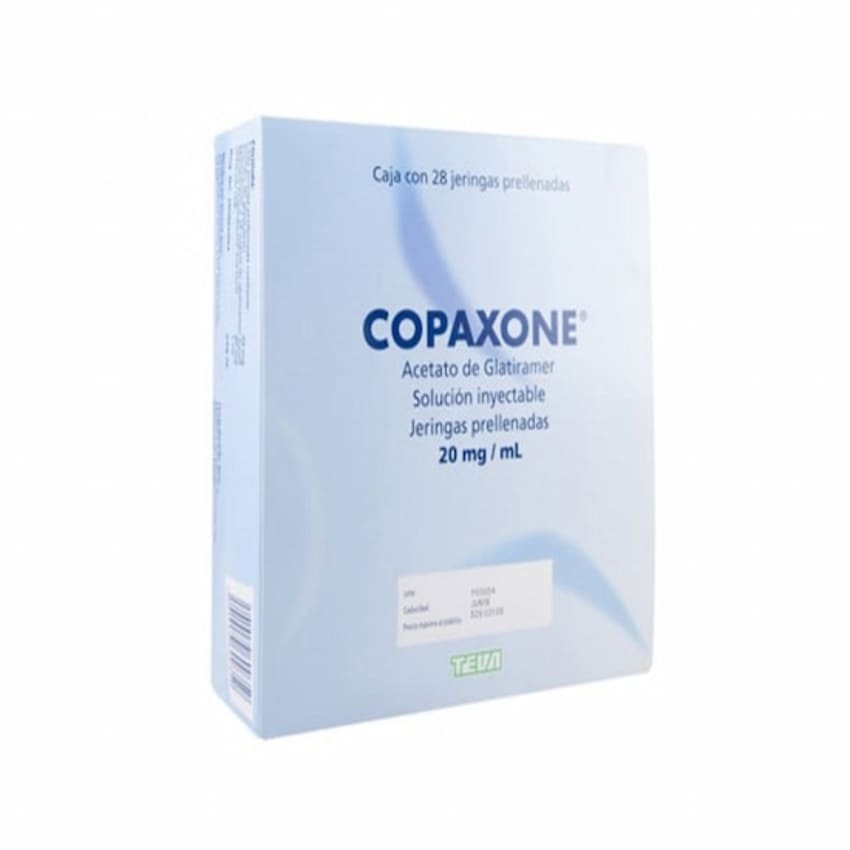
КОПАКСОН 20 мг/мл РАСТВОР ДЛЯ ИНЪЕКЦИЙ В ПРЕДНАПОЛНЕННОМ ШПРИЦЕ

Спросите врача о рецепте на КОПАКСОН 20 мг/мл РАСТВОР ДЛЯ ИНЪЕКЦИЙ В ПРЕДНАПОЛНЕННОМ ШПРИЦЕ

Инструкция по применению КОПАКСОН 20 мг/мл РАСТВОР ДЛЯ ИНЪЕКЦИЙ В ПРЕДНАПОЛНЕННОМ ШПРИЦЕ
Введение
Прошпект: Информация для пользователя
Копаксон 20 мг/мл раствор для инъекций в предварительно заполненном шприце
глатирамер, ацетат
Прочитайте внимательно весь прошпект перед началом использования этого лекарства, поскольку он содержит важную информацию для вас.
- Сохраните этот прошпект, поскольку вам может потребоваться прочитать его снова.
- Если у вас есть какие-либо вопросы, проконсультируйтесь с вашим врачом или фармацевтом.
- Это лекарство было назначено только вам, и не передавайте его другим людям, даже если у них такие же симптомы, как у вас, поскольку оно может нанести им вред.
- Если вы испытываете побочные эффекты, проконсультируйтесь с вашим врачом или фармацевтом, даже если это побочные эффекты, которые не указаны в этом прошпекте. См. раздел 4.
Содержание прошпекта:
- Что такое Копаксон и для чего он используется
- Что вам нужно знать перед началом использования Копаксона
- Как использовать Копаксон
- Возможные побочные эффекты
- Хранение Копаксона
- Содержание упаковки и дополнительная информация
1. Что такое Копаксон и для чего он используется
Копаксон - это лекарство, показанное для лечения рецидивирующих форм рассеянного склероза (РС). Он изменяет работу иммунной системы вашего организма и классифицируется как иммуномодулирующий агент. Считается, что симптомы рассеянного склероза (РС) возникают из-за дефекта иммунной системы организма. Это приводит к образованию зон воспаления в мозге и спинном мозге.
Копаксон используется для снижения частоты рецидивов РС. Не было доказано, что он помогает, если у вас есть форма РС, не имеющая рецидивов, или почти не имеющая рецидивов. Копаксон может не иметь никакого эффекта на продолжительность рецидива РС или на тяжесть симптомов во время рецидива.
Он используется для лечения пациентов, которые могут ходить без помощи.
Копаксон также может использоваться у пациентов, которые впервые испытывают симптомы, указывающие на высокий риск развития РС. Ваш врач исключит любую другую причину, которая может объяснить эти симптомы, прежде чем начать лечение.
2. Что вам нужно знать перед началом использования Копаксона
Не используйте Копаксон
- если вы аллергичны к ацетату глатирамера или к любому другому компоненту этого лекарства (перечисленному в разделе 6).
Предостережения и меры предосторожности
Копаксон может вызывать тяжелые аллергические реакции, некоторые из которых могут быть потенциально смертельными.
Эти реакции могут возникнуть вскоре после введения, даже через месяцы или годы после начала лечения, и даже если не возникли аллергические реакции после предыдущих введений.
Симптомы аллергических реакций могут перекрываться с реакциями после инъекции. Ваш врач проинформирует вас о симптомах аллергической реакции.
Проконсультируйтесь с вашим врачом или фармацевтом перед началом использования Копаксона, если у вас есть проблемы с почками или сердцем, поскольку вам может потребоваться проведение периодических анализов или осмотров.
Проконсультируйтесь с вашим врачом или фармацевтом перед началом использования Копаксона, если у вас есть или были проблемы с печенью (включая проблемы, связанные с употреблением алкоголя).
Дети
Копаксон не может использоваться у детей младше 12 лет.
Пациенты пожилого возраста
Копаксон не был специально изучен у пациентов пожилого возраста. Пожалуйста, проконсультируйтесь с вашим врачом.
Использование Копаксона с другими лекарствами
Сообщите вашему врачу или фармацевту, если вы используете, недавно использовали или можете использовать любое другое лекарство.
Беременность и лактация
Если вы беременны, считаете, что можете быть беременной или планируете стать беременной, проконсультируйтесь с вашим врачом о лечении Копаксоном во время беременности.
Копаксон может использоваться во время беременности по назначению вашего врача.
Ограниченные данные у людей не показали негативных эффектов Копаксона на новорожденных/детей, находящихся на грудном вскармливании. Копаксон может использоваться во время лактации.
Вождение и использование машин
Неизвестно, влияет ли Копаксон на способность управлять транспортными средствами или работать с машинами.
3. Как использовать Копаксон
Следуйте точно инструкциям по введению этого лекарства, указанным вашим врачом. В случае сомнений проконсультируйтесь снова с вашим врачом или фармацевтом.
Рекомендуемая суточная доза для взрослых и подростков старше 12 лет составляет один предварительно заполненный шприц (20 мг ацетата глатирамера), вводимый под кожу (подкожно).
Очень важно, чтобы инъекция Копаксона была проведена правильно:
- Только в ткани под кожей (подкожное использование) (см. «Инструкции по использованию»)
- В дозе, указанной вашим врачом. Используйте только назначенную вашим врачом дозу.
- Никогда не используйте один и тот же шприц более одного раза. Любой непотребованный или оставшийся продукт должен быть утилизирован.
- Не смешивайте или сочетайте содержимое предварительно заполненных шприцев Копаксона с любым другим продуктом.
- Если раствор содержит частицы, не используйте его. Используйте новый шприц.
Впервые, когда вы используете Копаксон, вам будут даны полные инструкции, и вас будет наблюдать врач или медсестра. Они будут с вами во время инъекции и еще 30 минут после, только чтобы убедиться, что у вас нет проблем.
Инструкции по использованию
Прочитайте эти инструкции внимательно перед использованием Копаксона.
Перед инъекцией убедитесь, что у вас есть все необходимое:
- Блистер с предварительно заполненным шприцем Копаксона.
- Контейнер для утилизации использованных игл и шприцев.
- Для каждой инъекции выньте только один блистер с предварительно заполненным шприцем из упаковки. Храните остальные шприцы в коробке.
- Если ваш шприц находился в холодильнике, выньте блистер, содержащий шприц, как минимум за 20 минут до того, как вы собираетесь сделать инъекцию, чтобы он нагрелся до комнатной температуры.
Тщательно вымойте руки водой и мылом.
Если вы хотите использовать устройство для инъекции, чтобы сделать инъекцию, устройство CSYNC может использоваться с Копаксоном. Устройство CSYNC разрешено только для использования с КОПАКСОНОМ и не было протестировано с другими продуктами. Пожалуйста, прочитайте инструкции по использованию, предоставленные вместе с устройством для инъекции CSYNC.
Выберите место для инъекции внутри указанных областей, следуя диаграммам.
Существует семь возможных зон для инъекции на вашем теле:
Область 1: Область живота (абдомена) вокруг пупка. Избегайте делать инъекцию в 5 см с каждой стороны от пупка.
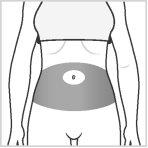
Области 2 и 3: Бедра (над коленями)
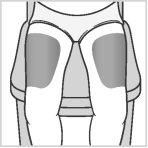
Области 4, 5, 6 и 7: Верхняя часть рук и верхняя часть бедер (ниже талии)
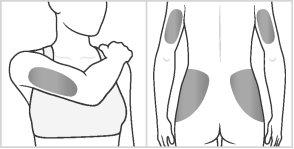
В каждой области инъекции существует множество мест для инъекции. Каждый день выбирайте разное место для инъекции. Таким образом, вы уменьшите вероятность раздражения или боли в месте инъекции. Меняйте области инъекции и также меняйте место инъекции внутри каждой области. Не используйте всегда одно и то же место для инъекции.
Предупреждение: не делайте инъекцию в любую зону, которая болит или без цвета, или в месте, где вы заметили узлы или твердые уплотнения.
Рекомендуется иметь схему с запланированными местами инъекции и записывать их в дневник. Существуют некоторые места на вашем теле, которые могут быть трудными для самостоятельной инъекции (например, задняя часть руки). Если вы хотите использовать их, вам может потребоваться помощь.
Как сделать инъекцию:
- Выньте шприц из защитного блистера, сняв крышку блистера.
- Снимите колпачок с иглы, не снимайтезащитный колпачок с помощью рта или зубов.
- Аккуратно сожмите кожу, сделав складку между большим и указательным пальцами свободной руки (Рисунок 1).
- Аккуратно введите иглу в кожу, как показано на Рисунке 2.
- Введение лекарства, đẩyая поршень, твердо до упора, оставив шприц пустым.
- Выньте шприц и иглу.
- Утилизируйте шприц в безопасном контейнере для отходов. Не выбрасывайте использованные шприцы в мусор, осторожно поместите их в контейнер, устойчивый к проколам, как рекомендовал ваш врач или медсестра.

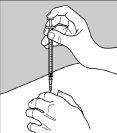
Рисунок 1 Рисунок 2
Если вы считаете, что эффект Копаксона слишком сильный или слабый, сообщите об этом вашему врачу.
Если вы использовали больше Копаксона, чем должно быть
В случае передозировки или случайного приема внутрь немедленно проконсультируйтесь с вашим врачом, фармацевтом или позвоните в Службу информации о токсичности, телефон 915620420, указав лекарство и количество, принятое внутрь.
Если вы пропустили использование Копаксона
Примените его, как только вспомните, но не принимайте двойную дозу, чтобы компенсировать пропущенные дозы. Примените следующую дозу через 24 часа.
Если вы прекратили лечение Копаксоном
Не прекращайте использовать Копаксон без консультации с вашим врачом.
Если у вас есть какие-либо другие вопросы о использовании этого лекарства, проконсультируйтесь с вашим врачом или фармацевтом.
4. Возможные побочные эффекты
Как и все лекарства, это лекарство может вызывать побочные эффекты, хотя не все люди испытывают их.
Аллергические реакции (гиперчувствительность, анафилактическая реакция)
Вы можете развить тяжелую аллергическую реакцию на это лекарство вскоре после введения. Это редкий побочный эффект. Эти реакции могут возникнуть месяцы или годы после начала лечения Копаксоном, даже если не возникли аллергические реакции после предыдущих введений.
Если вы заметите любой из следующих побочных эффектов внезапно, прекратите использовать Копаксон и немедленно позвоните вашему врачу или обратитесь в ближайший больничный отделение неотложной помощи:
- общий высыпание (красные пятна или сыпь)
- отек век, лица, губ, рта, горла или языка
- внезапная одышка, трудности с дыханием или свистящее дыхание (свистящие звуки при дыхании)
- судороги (припадки)
- трудности с глотанием или речью
- обморок (потеря сознания), чувство головокружения или обморока
- коллапс
Другие реакции после инъекции (реакция сразу после инъекции)
Редко, но некоторые люди могут испытывать один или несколько следующих симптомов через несколько минут после инъекции Копаксона. Обычно они не представляют проблемы и проходят в течение получаса.
Однако, если следующие симптомы продолжаются более 30 минут, немедленно свяжитесь с вашим врачом или обратитесь в ближайший больничный отделение неотложной помощи:
- краснота груди или лица (расширение кровеносных сосудов)
- трудности с дыханием (одышка)
- боль в груди
- быстрое или сильное сердцебиение (пальпитация, тахикардия)
Проблемы с печенью (гепатические проблемы)
Проблемы с печенью или ухудшение проблем с печенью, включая печеночную недостаточность (которая в некоторых случаях привела к трансплантации печени), могут возникать редко при использовании Копаксона. Немедленно свяжитесь с вашим врачом, если у вас есть симптомы, такие как:
- тошнота
- потеря аппетита
- темная моча и светлый стул
- желтушная окраска кожи или белой части глаза
- легкое кровотечение
Следующие побочные эффекты были сообщены для Копаксона:
Очень часто: могут возникать у более 1 из 10 человек
- инфекции, грипп
- тревога, депрессия
- головная боль
- тошнота
- сыпь на коже
- боль в суставах или спине
- чувство слабости, реакции кожи в месте инъекции, включая покраснение кожи, боль, образование пузырей, зуд, отек тканей, воспаление и гиперчувствительность (эти реакции в месте инъекции не являются аномальными и обычно проходят со временем), неспецифическая боль.
Часто: могут возникать у до 1 из 10 человек
- воспаление дыхательных путей, желудочно-кишечные заболевания, лихорадка, воспаление ушей, насморк, абсцессы зубов, вагинальный кандидоз
- доброкачественные новообразования кожи (доброкачественные кожные опухоли), новообразования
- отек лимфатических узлов
- аллергические реакции
- потеря аппетита, набор веса
- нервозность
- нарушение вкуса, увеличение мышечного тонуса, мигрень, проблемы с речью, обморок, тремор
- двойное зрение, проблемы с глазами
- проблемы со слухом
- кашель, сенная лихорадка
- анальные или прямокишечные проблемы, запор, кариес зубов, диспепсия, трудности с глотанием, недержание кала, рвота.
- анормальные результаты функциональных тестов печени
- синяки, чрезмерное потоотделение, зуд, кожные реакции, крапивница
- боль в шее
- необходимость быстро опорожнить мочевой пузырь, частое мочеиспускание, неспособность полностью опорожнить мочевой пузырь
- озноб, отек лица, потеря ткани под кожей в месте инъекции, местная реакция, периферический отек, лихорадка.
Редко: могут возникать у до 1 из 100 человек
- абсцессы, воспаление кожи и мягких тканей, фурункулы, герпес, воспаление почек
- кожный рак
- увеличение количества белых кровяных клеток, уменьшение количества белых кровяных клеток, увеличение селезенки, уменьшение количества тромбоцитов, изменение формы белых кровяных клеток
- увеличение щитовидной железы или гипертиреоз
- пониженная толерантность к алкоголю, подагра, увеличение уровня жиров в крови, увеличение натрия в крови, уменьшение ферритина в крови.
- страные сны, замешательство, эйфория, видение, слышание, обоняние, осязание или ощущение вещей, которых нет (галлюцинации), агрессия, аномально счастливое состояние, расстройства личности, попытка самоубийства
- онемение рук и боль (синдром запястного канала), психические расстройства, судороги (припадки), проблемы с письмом и чтением, мышечные расстройства, проблемы с движением, мышечные спазмы, воспаление нервов, аномальная связь между нервом и мышцей, вызывающая аномальную мышечную функцию, быстрое и непроизвольное движение глазных яблок, паралич, падение стопы (паралич перонеального нерва), бессознательное состояние (ступор), слепые пятна.
- катаракта, повреждения роговицы, сухость глаз, кровотечение в глазу, птоз, расширение зрачка, дегенерация зрительного нерва.
- учащенное сердцебиение, замедленное сердцебиение, эпизоды быстрого сердцебиения
- варикозное расширение вен
- периодические остановки дыхания, носовое кровотечение, аномально быстрое или глубокое дыхание (гипервентилация), чувство сужения горла, проблемы с легкими, неспособность дышать из-за сужения горла (чувство удушья)
- воспаление тонкого кишечника, полипы в толстой кишке, воспаление кишечника, отрыжка, язва горла, воспаление десен, кровотечение из прямой кишки, увеличение слюнных желез
- желчные камни, увеличение печени
- отек кожи и мягких тканей, контактный дерматит, болезненные красные узлы на коже, узлы на коже
- отек, воспаление и боль в суставах (артрит или остеоартрит), воспаление и боль в суставных сумках (существующих в некоторых суставах), боль в боку, уменьшение мышечной массы
- кровь в моче, камни в почках, проблемы с мочевой системой, аномалии мочи
- отек груди, трудности с эрекцией, опущение или смещение тазовых органов (опущение тазовых органов), длительная эрекция, изменения в предстательной железе, аномальный результат пап-теста (анормальный мазок шейки матки), изменения в яичках, вагинальное кровотечение, вагинальные расстройства.
- киста, похмелье, пониженная температура тела (гипотермия), неспецифическое воспаление, разрушение тканей в месте инъекции, проблемы с слизистыми оболочками
- изменения после вакцинации
Сообщение о побочных эффектах
Если вы испытываете любой побочный эффект, проконсультируйтесь с вашим врачом или фармацевтом, даже если это возможные побочные эффекты, которые не указаны в этом прошпекте. Вы также можете сообщить об этом напрямую через Испанскую систему фармакологического мониторинга лекарств для человека: https://www.notificaram.es. Сообщая о побочных эффектах, вы можете внести свой вклад в предоставление более полной информации о безопасности этого лекарства.
5. Хранение Копаксона
Хранить это лекарство в недоступном для детей месте.
Не использовать это лекарство после даты истечения срока годности, указанной на этикетке и упаковке (CAD или EXP). Дата истечения срока годности - последний день указанного месяца.
Хранить в холодильнике (при температуре между 2 °C и 8 °C).
Раствор Копаксона для инъекций в предварительно заполненном шприце можно хранить до одного месяца вне холодильника при температуре между 15 °C и 25 °C. Это можно сделать только один раз. Если после этого периода в один месяц предварительно заполненные шприцы Копаксона не были использованы и все еще находятся в оригинальной упаковке, их необходимо снова хранить в холодильнике.
Не замораживать.
Предварительно заполненные шприцы должны храниться в оригинальной упаковке, защищенные от света.
Утилизировать любой шприц, содержащий частицы.
Лекарства не должны выбрасываться в канализацию или в мусор. Поместите упаковку и лекарства, которые вам больше не нужны, в пункт SIGRE аптеки. Если у вас есть сомнения, спросите у вашего фармацевта, как утилизировать упаковку и лекарства, которые вам больше не нужны. Таким образом, вы поможете защитить окружающую среду.
6. Содержание упаковки и дополнительная информация
Состав Копаксона
- Активное вещество - ацетат глатирамера. 1 мл раствора для инъекций (содержимое 1 предварительно заполненного шприца) содержит 20 мг ацетата глатирамера, что эквивалентно 18 мг глатирамера.
- Другие компоненты - маннитол и вода для инъекций.
Внешний вид продукта и содержание упаковки
Раствор Копаксона для инъекций в предварительно заполненном шприце - стерильный, прозрачный раствор без видимых частиц.
Каждый предварительно заполненный шприц упакован индивидуально в блистерную упаковку из ПВХ.
Копаксон выпускается в упаковках, содержащих 7, 28 или 30 предварительно заполненных шприцев по 1 мл раствора для инъекций, или в многоупаковке из 90 предварительно заполненных шприцев, состоящей из 3 упаковок, каждая из которых содержит 30 предварительно заполненных шприцев по 1 мл раствора для инъекций.
Возможно, что будут продаваться только некоторые размеры упаковок.
Владелец разрешения на маркетинг и ответственное лицо за производство
Владелец разрешения на маркетинг
Teva GmbH
Graf Arco Strasse 3
89079 Ульм
Германия
Ответственное лицо за производство
Norton Healthcare Limited T/A IVAX Pharmaceuticals UK (Teva Runcorn)
Aston Lane North, Whitehouse Vale Industrial Estate
Runcorn, Cheshire, WA7 3FA
Великобритания
или
Actavis Group PTC ehf.
Dalshraun 1,
220 Хафнарфьордюр
Исландия
или
Merckle GmBH
Graf Arco Strasse 3
Ульм - D-89079
Германия
Это лекарство разрешено в государствах-членах Европейского экономического пространства под названиемКОПАКСОН 20 мг/мл:
Германия, Австрия, Бельгия, Хорватия, Чехия, Кипр, Дания, Словакия, Словения, Испания, Эстония, Финляндия, Франция, Греция, Венгрия, Ирландия, Исландия, Италия, Латвия, Литва, Люксембург, Мальта, Норвегия, Нидерланды, Польша, Португалия, Великобритания (Северная Ирландия), Румыния, Швеция,
Вы можете получить более подробную информацию о этом лекарстве, обратившись к местному представителю владельца разрешения на маркетинг:
Teva Pharma, S.L.U.
C/ Anabel Segura, 11, Edificio Albatros B, 1-я пл.
28108, Алькобендас, Мадрид (Испания)
Дата последнего обновления этого листка инструкции: сентябрь 2024
Подробная и актуальная информация о этом лекарстве доступна на сайте Агентства по лекарственным средствам и медицинским изделиям Испании (AEMPS) http://www.aemps.gob.es/
Вы можете получить доступ к подробной и актуальной информации о этом лекарстве, отсканировав с помощью вашего мобильного телефона (смартфона) QR-код, включенный в картонную упаковку. Вы также можете получить доступ к этой информации на следующем сайте: https://cima.aemps.es/cima/dochtml/p/65983/P_65983.html
QR-код + URL.
- Страна регистрации
- Активное вещество
- Требуется рецептДа
- Производитель
- Информация носит справочный характер и не является медицинской рекомендацией. Перед приемом любых препаратов проконсультируйтесь с врачом. Oladoctor не несет ответственности за медицинские решения, принятые на основе этого контента.
- Аналоги КОПАКСОН 20 мг/мл РАСТВОР ДЛЯ ИНЪЕКЦИЙ В ПРЕДНАПОЛНЕННОМ ШПРИЦЕФорма выпуска: ИНЪЕКЦИОННЫЙ РАСТВОР, 40 мг/млАктивное вещество: Глатирамер ацетатПроизводитель: Teva GmbhТребуется рецептФорма выпуска: ИНЪЕКЦИОННЫЙ РАСТВОР, 20 мг/млАктивное вещество: Глатирамер ацетатПроизводитель: Viatris LimitedТребуется рецептФорма выпуска: ИНЪЕКЦИОННЫЙ РАСТВОР, 40 мг/млАктивное вещество: Глатирамер ацетатПроизводитель: Viatris LimitedТребуется рецепт
Аналоги КОПАКСОН 20 мг/мл РАСТВОР ДЛЯ ИНЪЕКЦИЙ В ПРЕДНАПОЛНЕННОМ ШПРИЦЕ в других странах
Лучшие аналоги с тем же действующим веществом и терапевтическим эффектом.
Аналог КОПАКСОН 20 мг/мл РАСТВОР ДЛЯ ИНЪЕКЦИЙ В ПРЕДНАПОЛНЕННОМ ШПРИЦЕ в Польша
Аналог КОПАКСОН 20 мг/мл РАСТВОР ДЛЯ ИНЪЕКЦИЙ В ПРЕДНАПОЛНЕННОМ ШПРИЦЕ в Украина
Врачи онлайн по КОПАКСОН 20 мг/мл РАСТВОР ДЛЯ ИНЪЕКЦИЙ В ПРЕДНАПОЛНЕННОМ ШПРИЦЕ
Консультация по дозировке, побочным эффектам, взаимодействиям, противопоказаниям и продлению рецепта на КОПАКСОН 20 мг/мл РАСТВОР ДЛЯ ИНЪЕКЦИЙ В ПРЕДНАПОЛНЕННОМ ШПРИЦЕ – по решению врача и с учетом местных правил.














